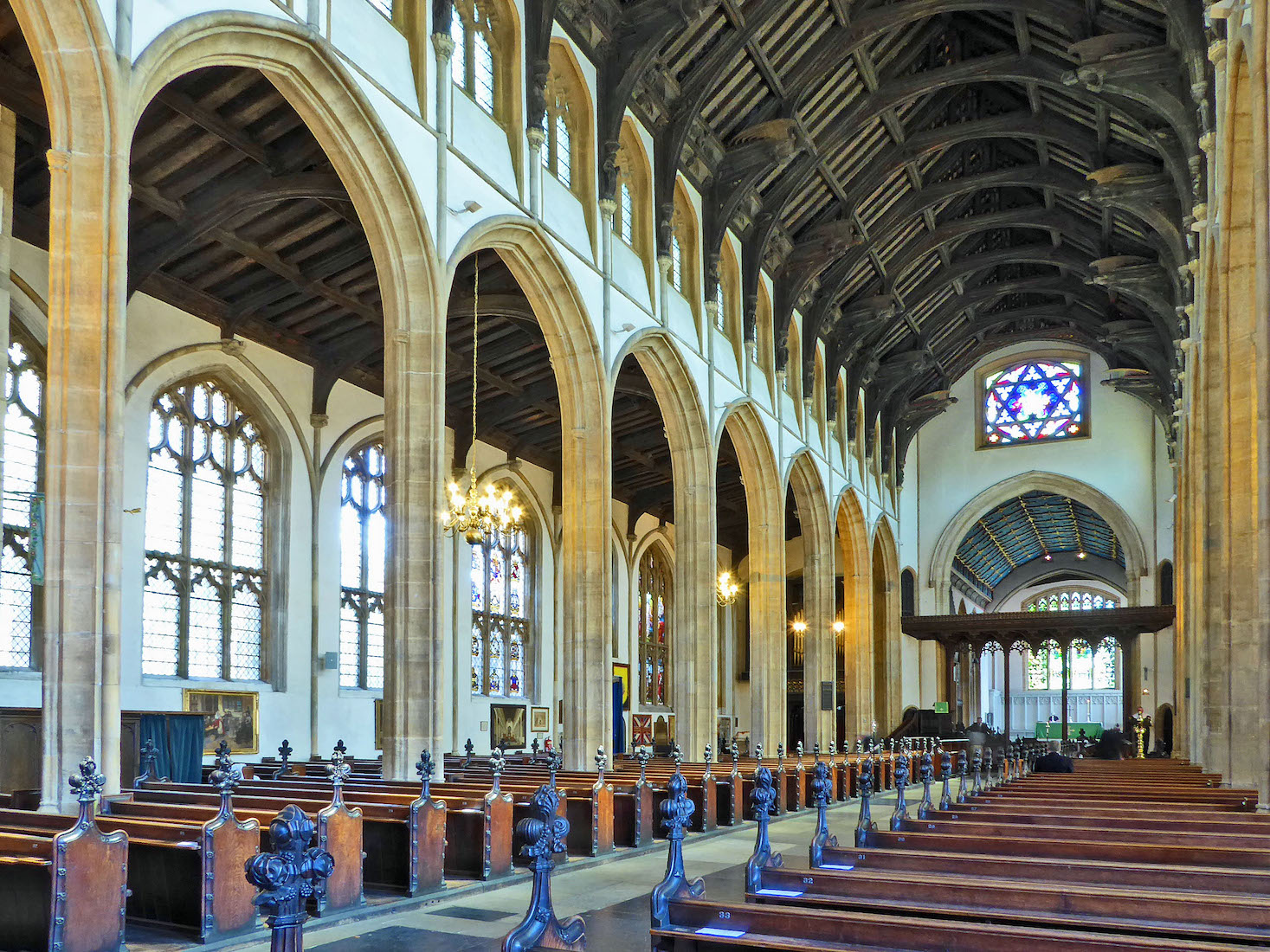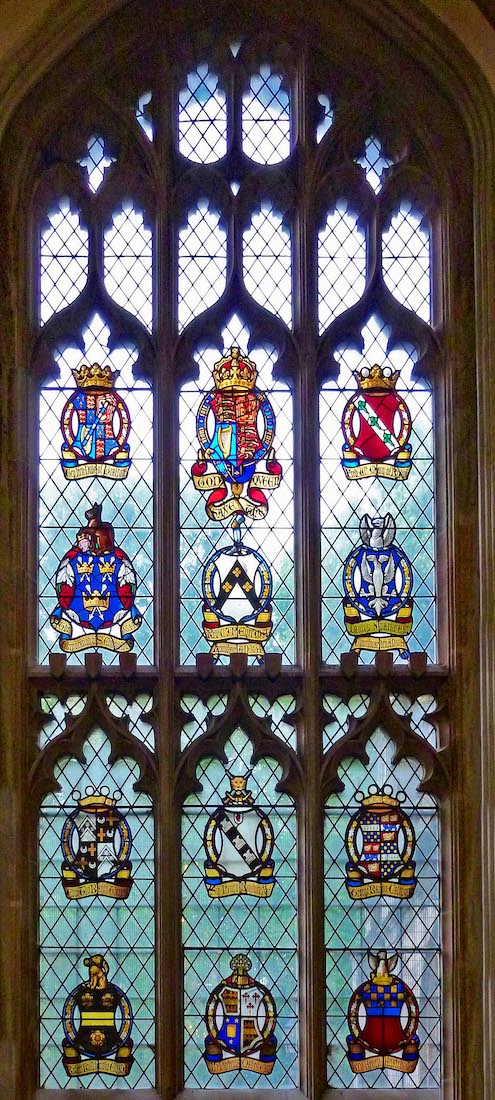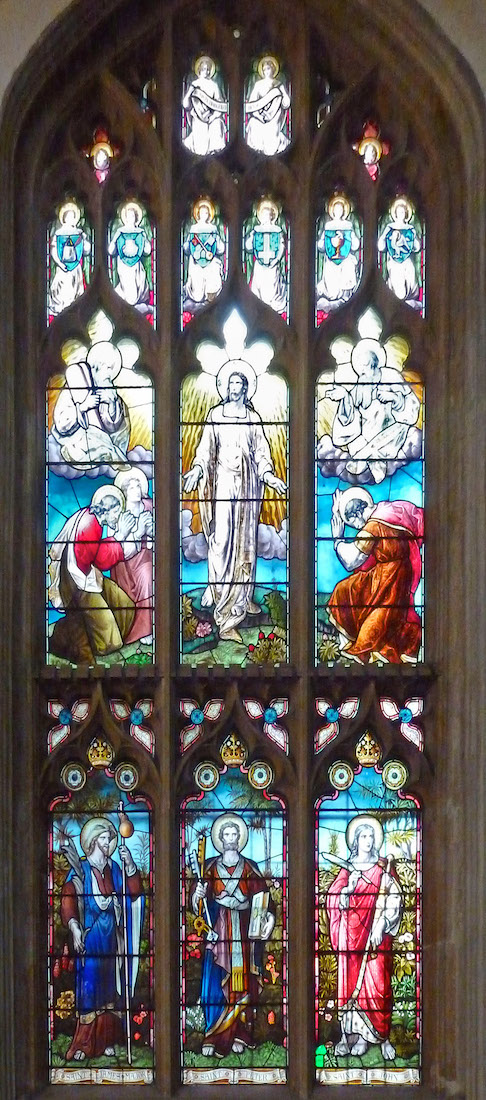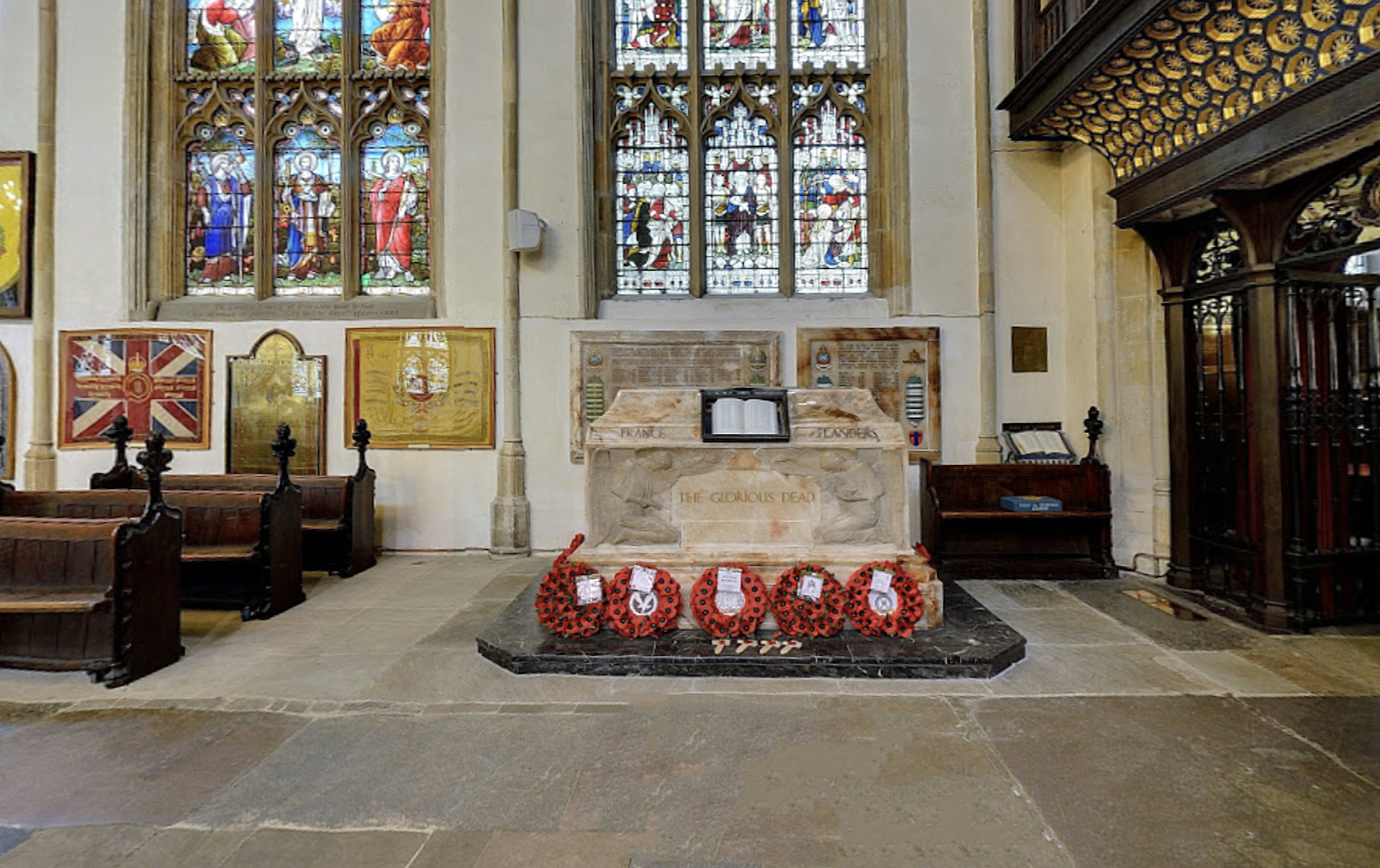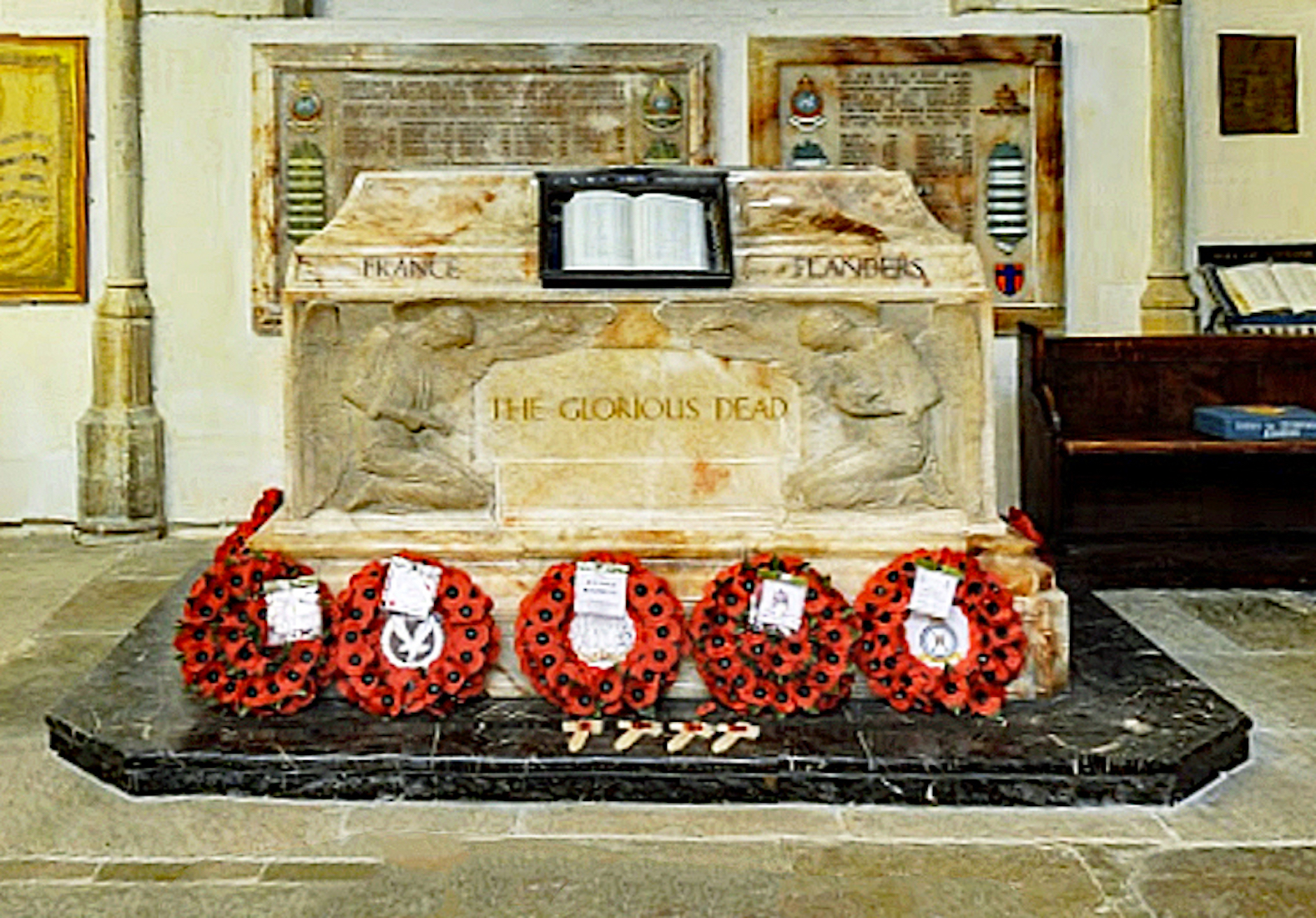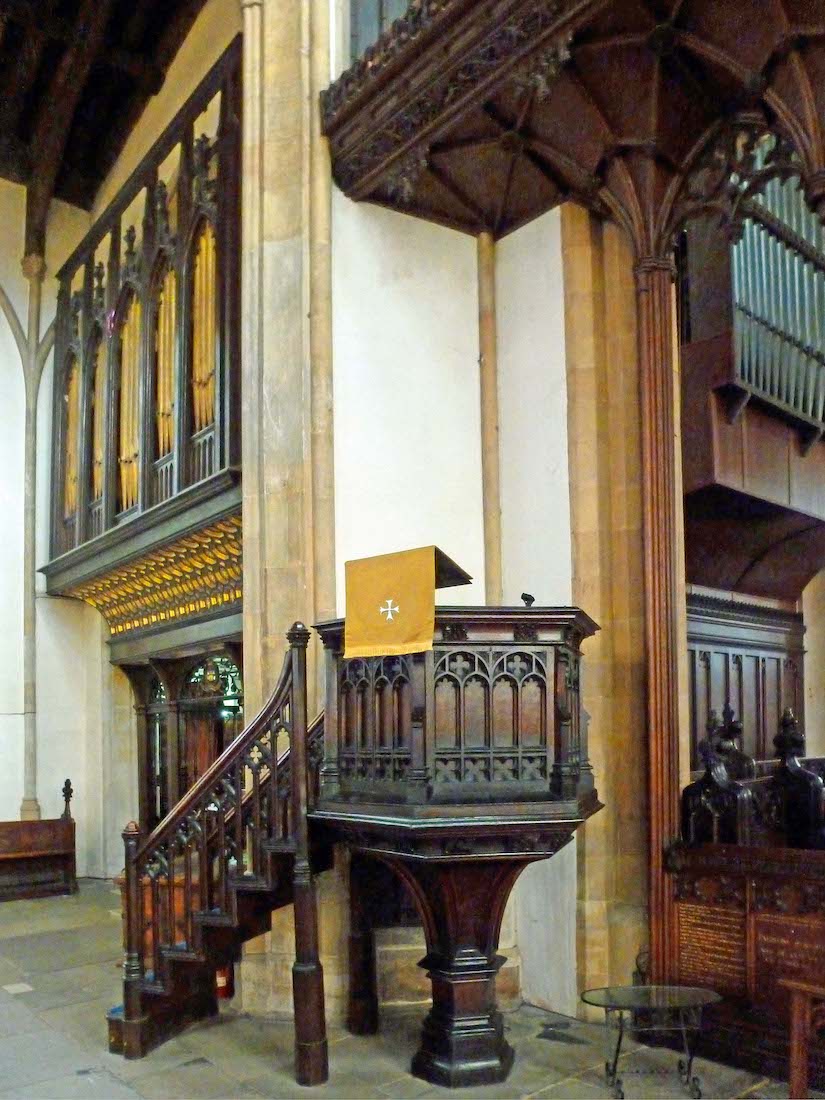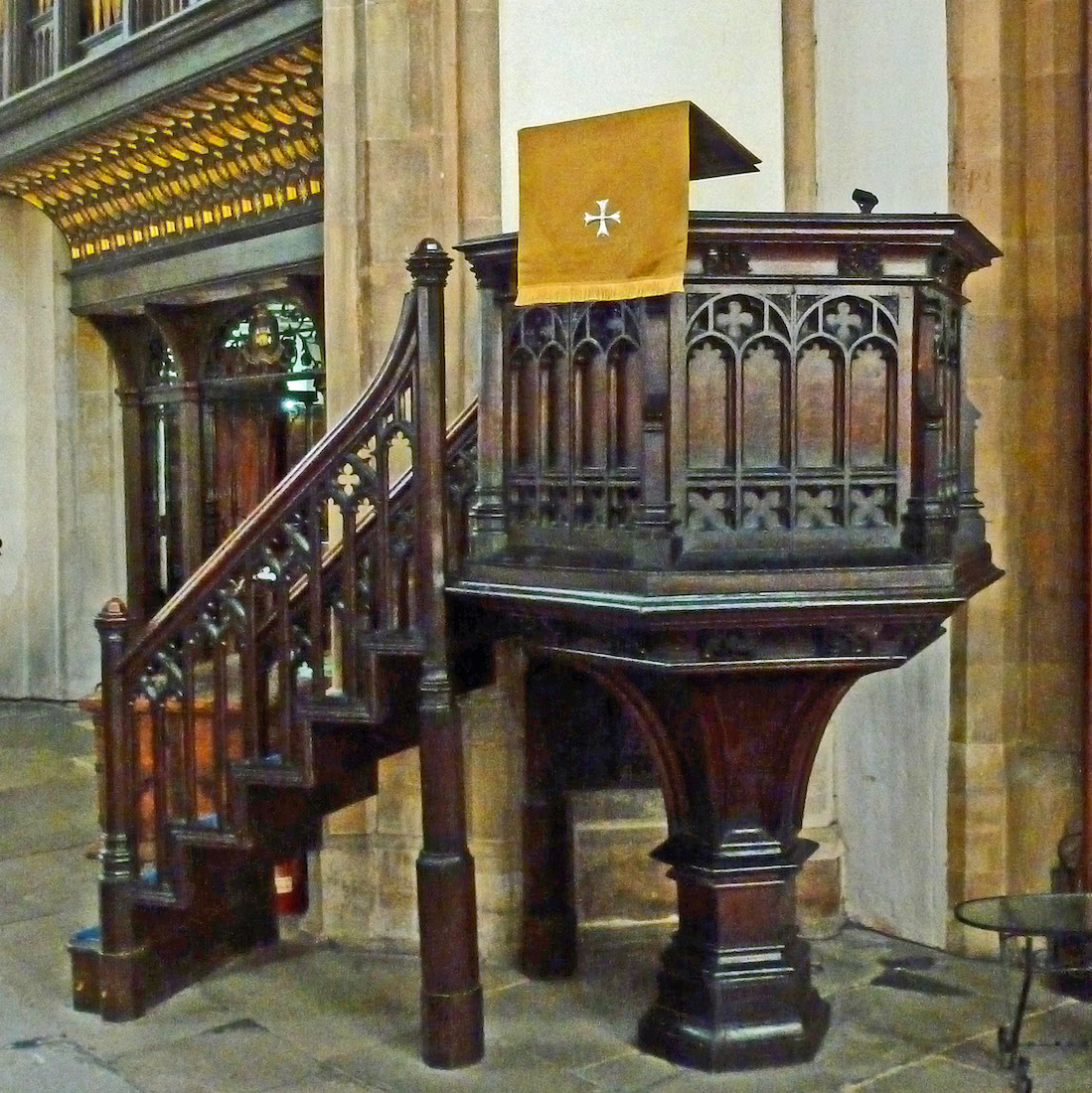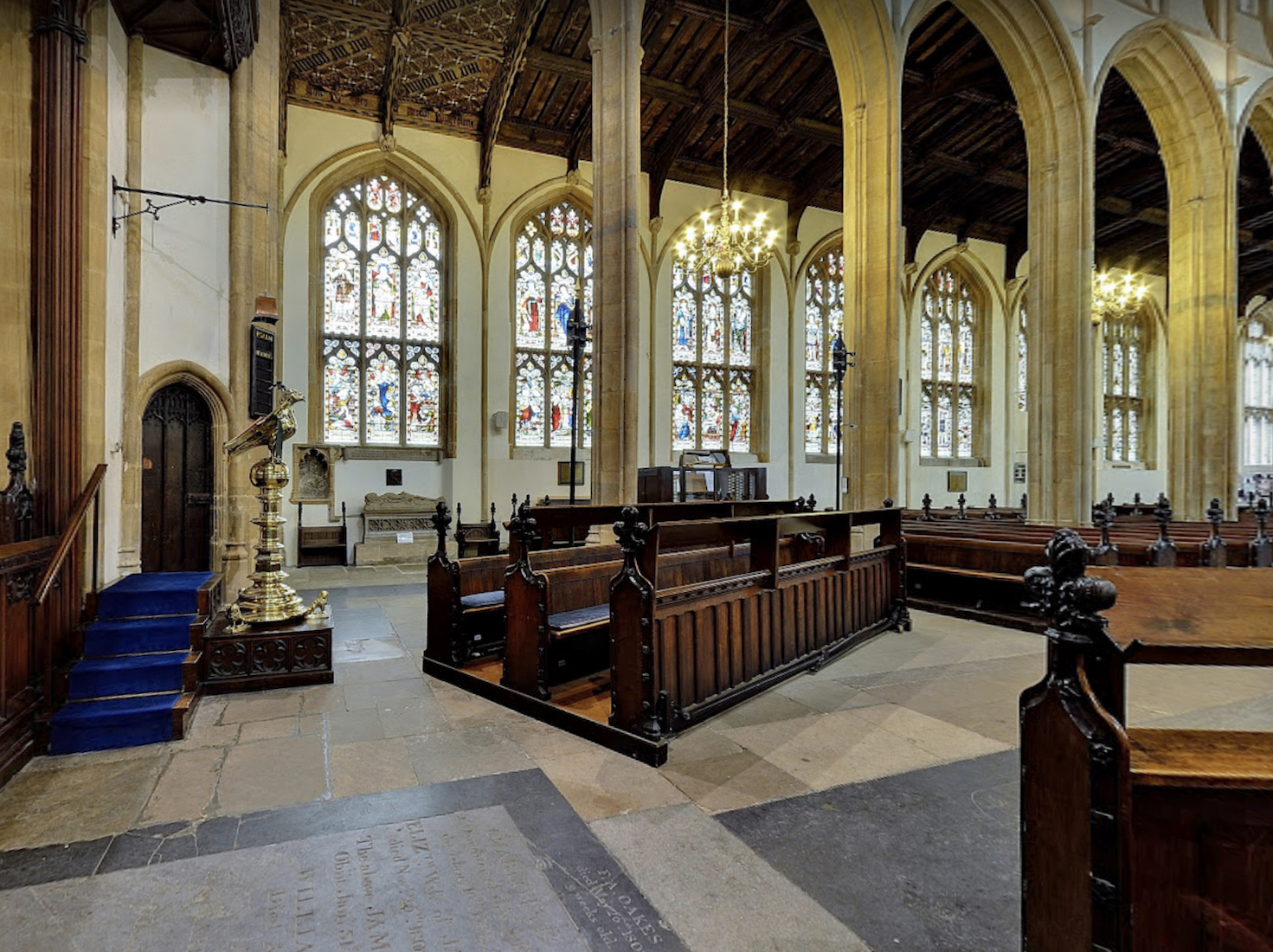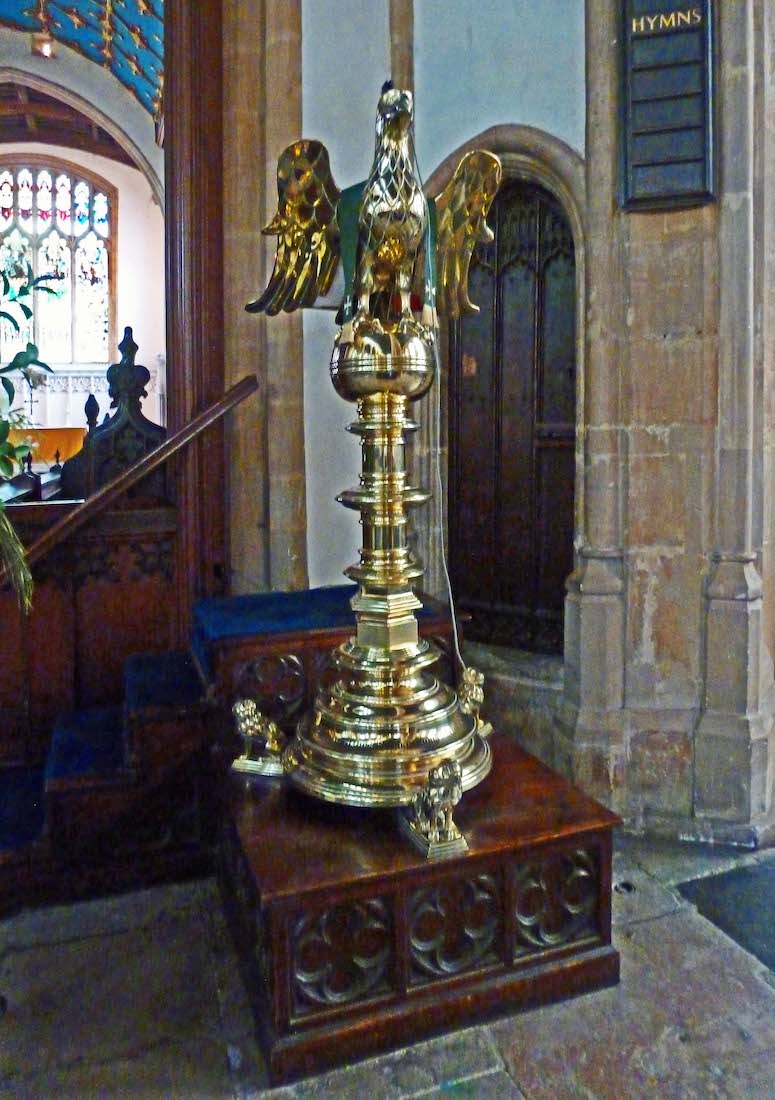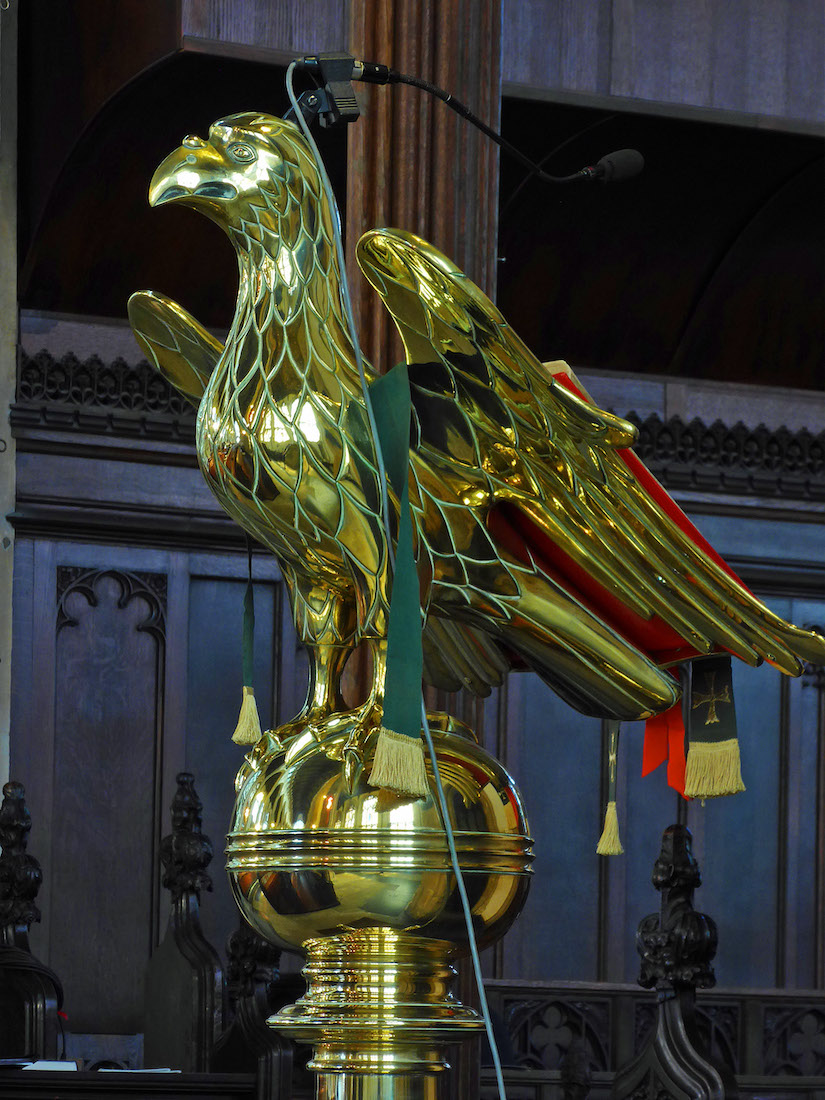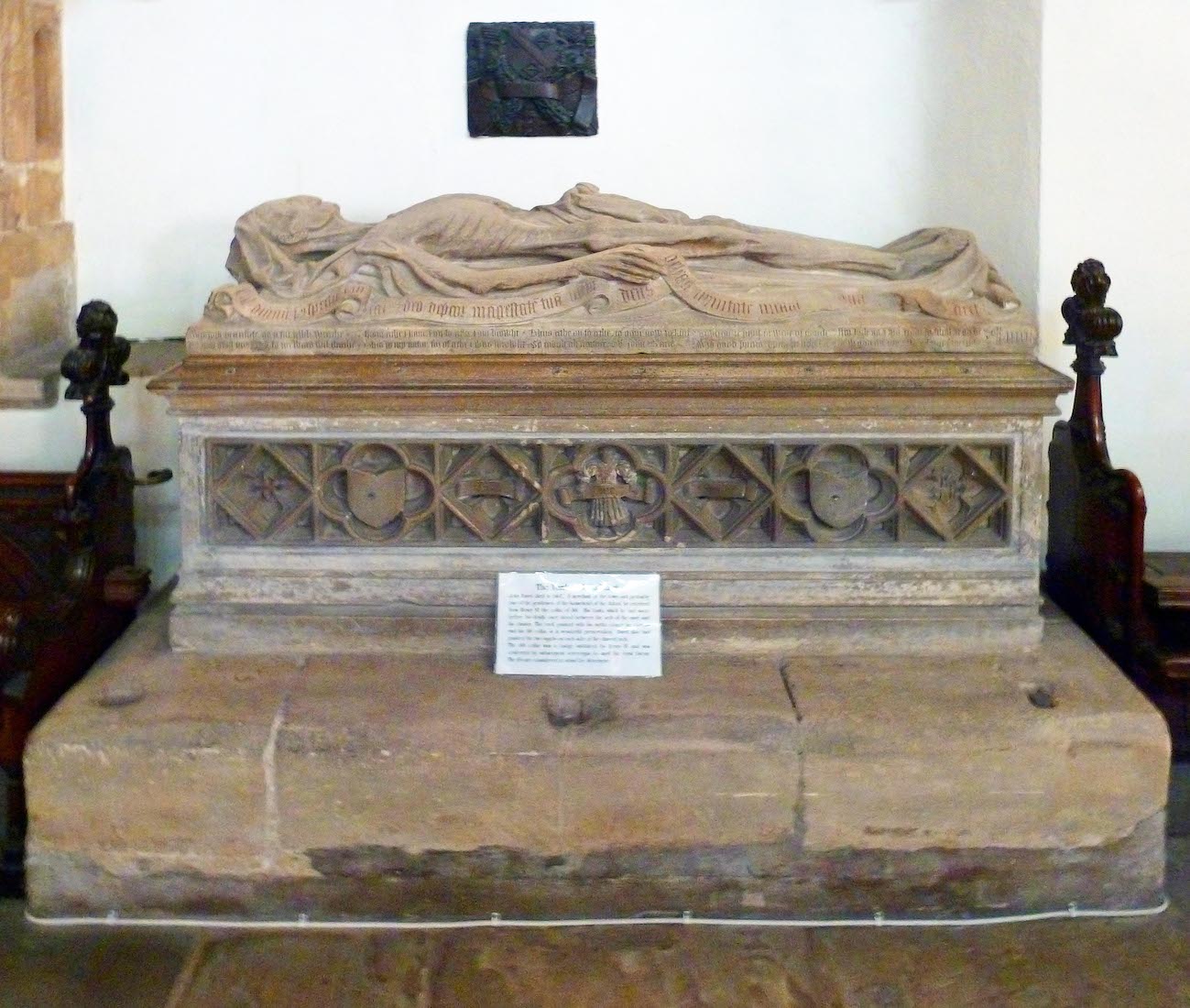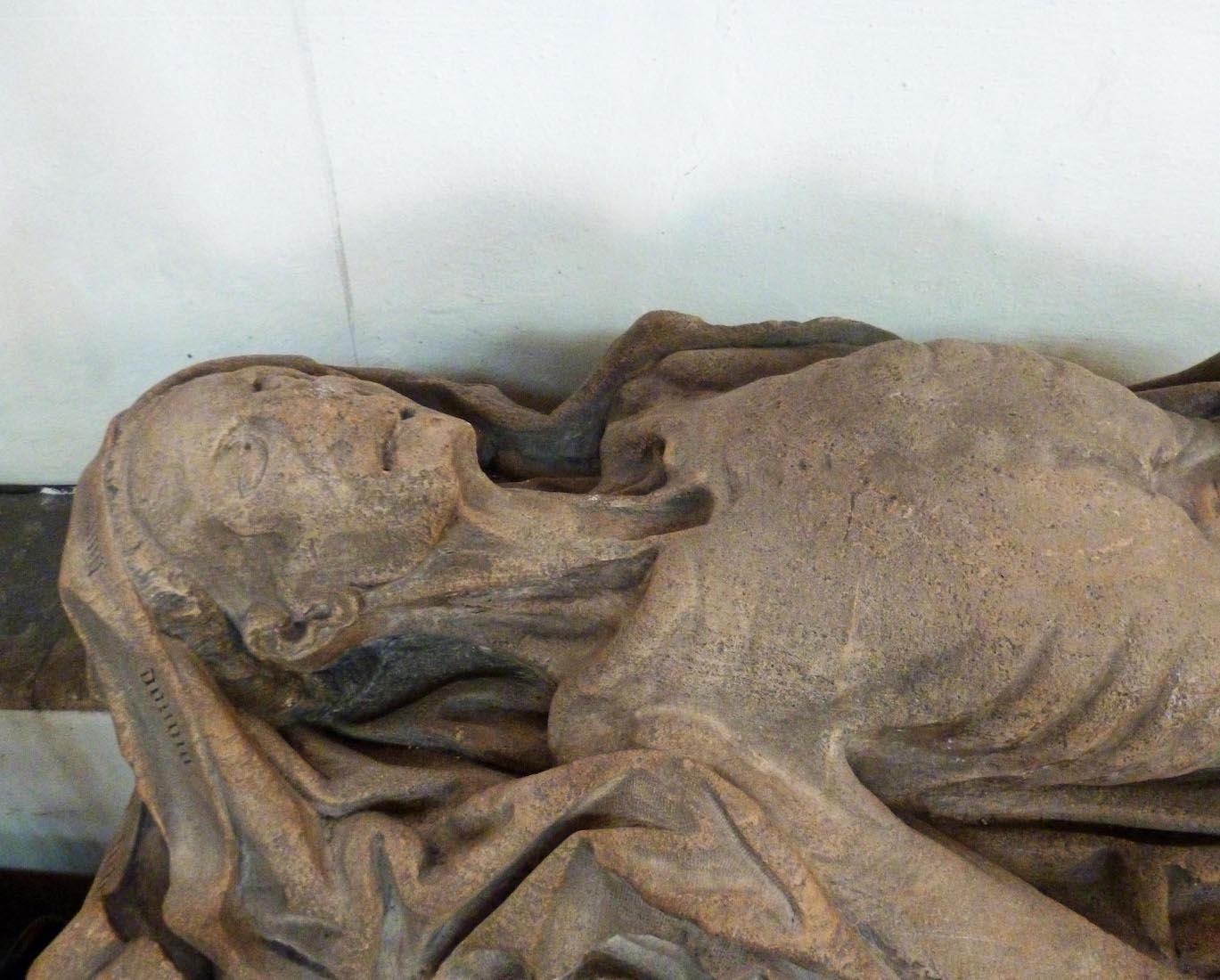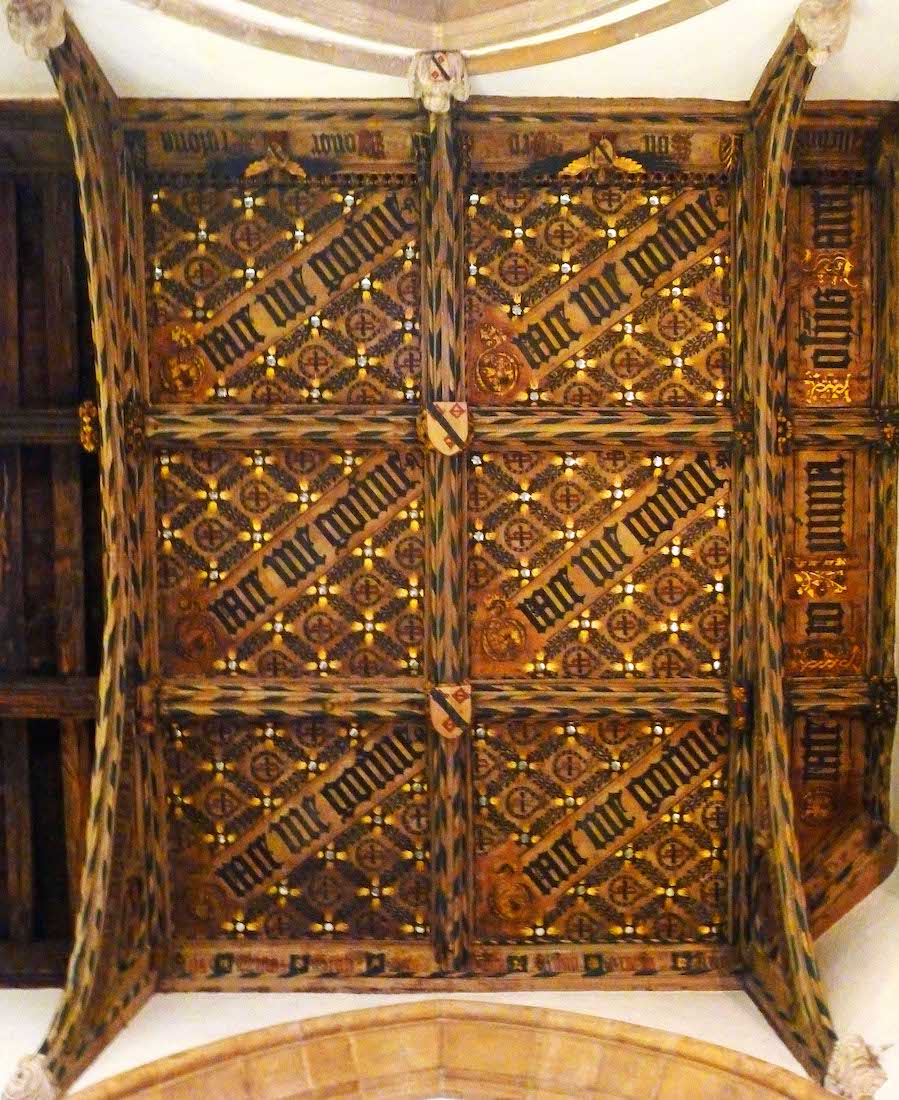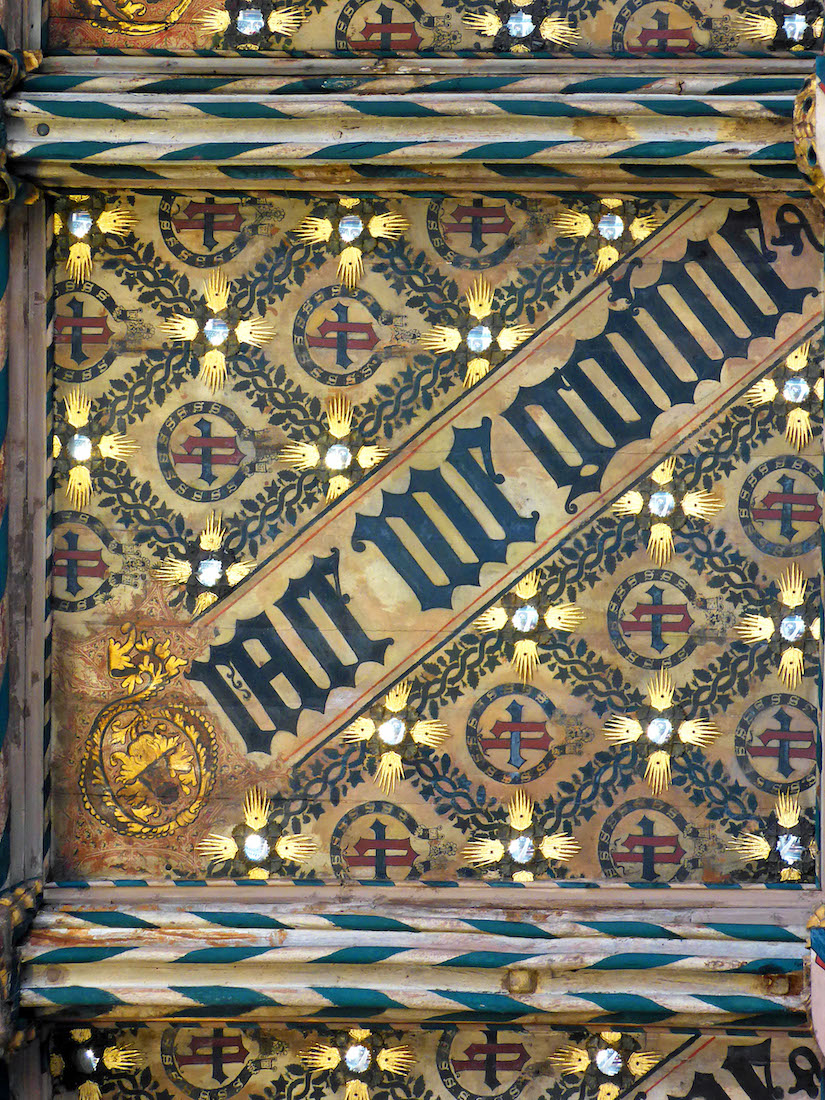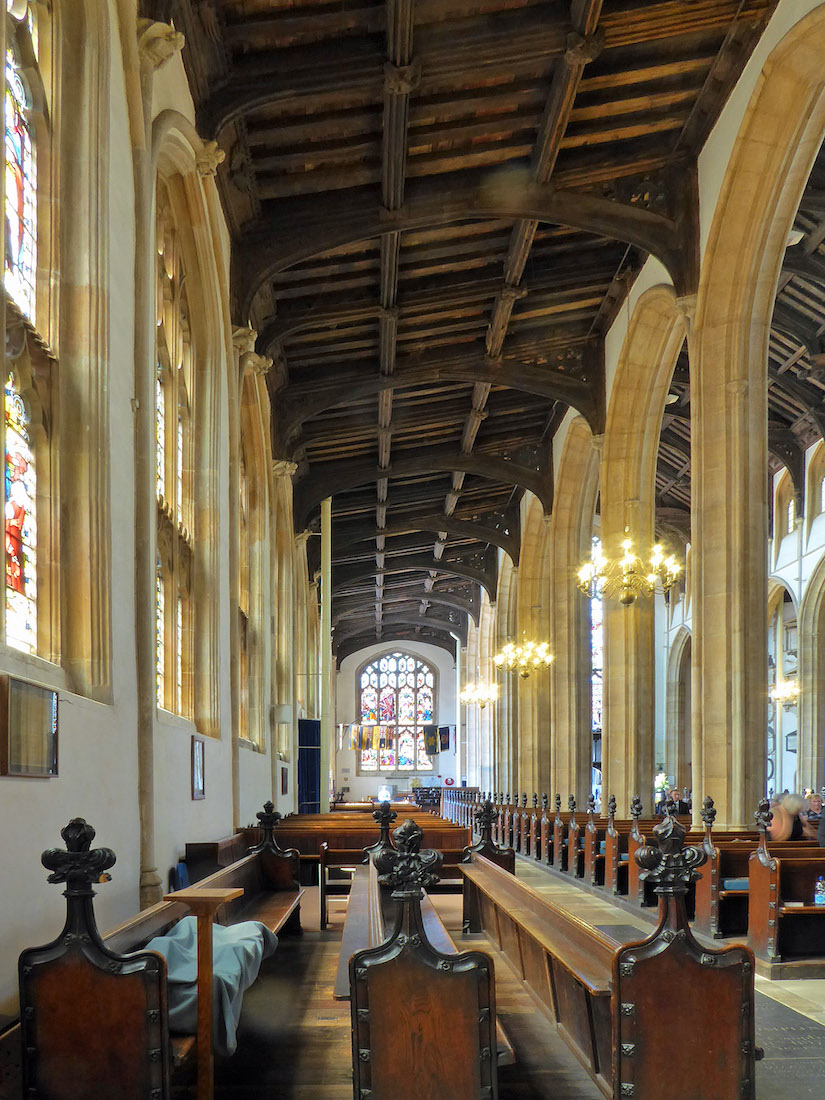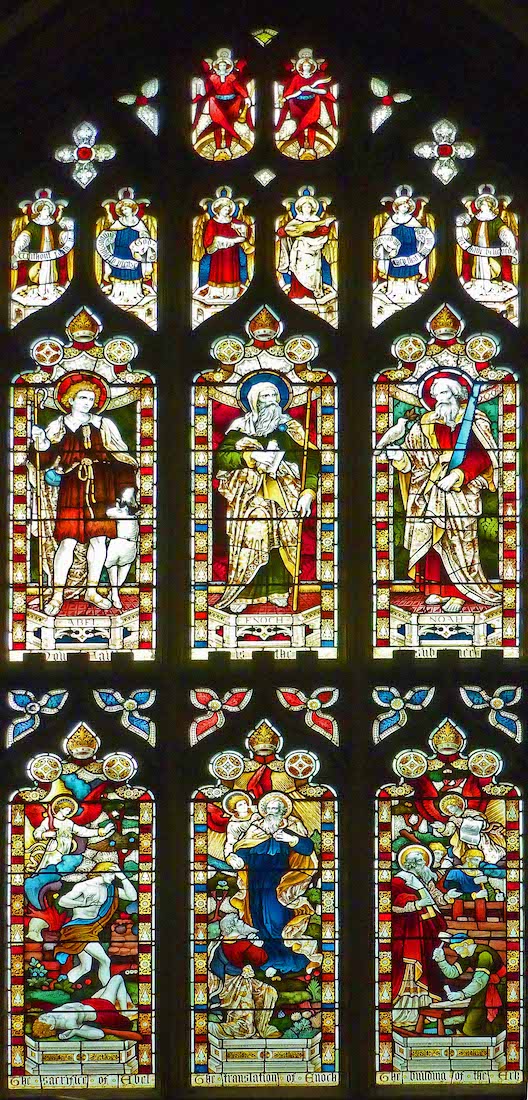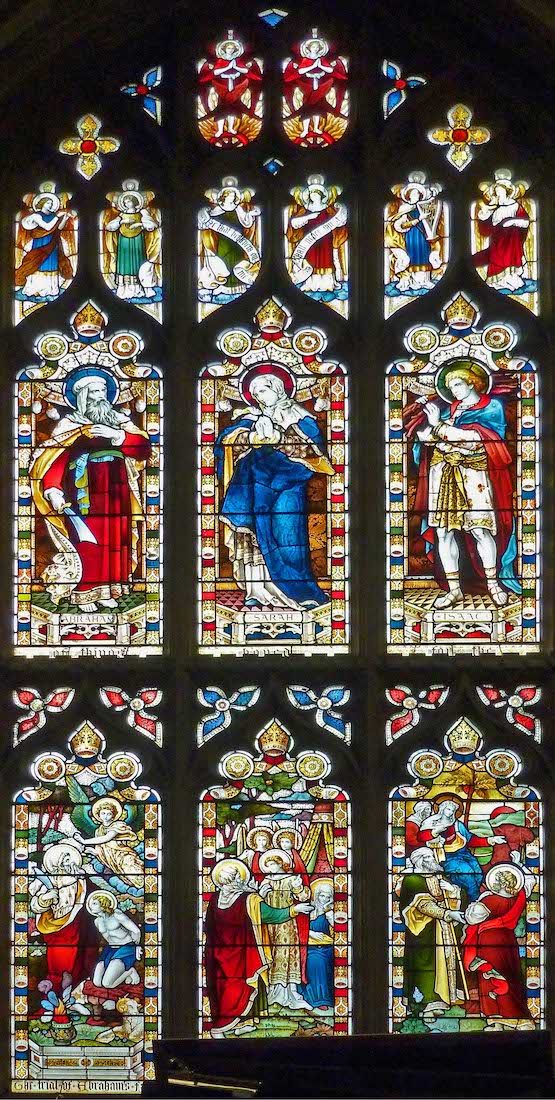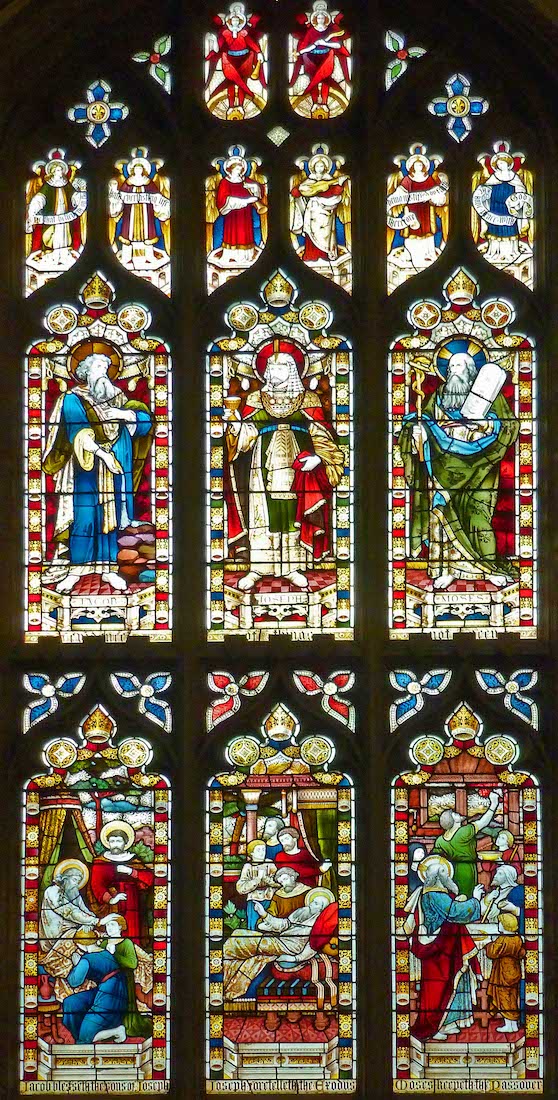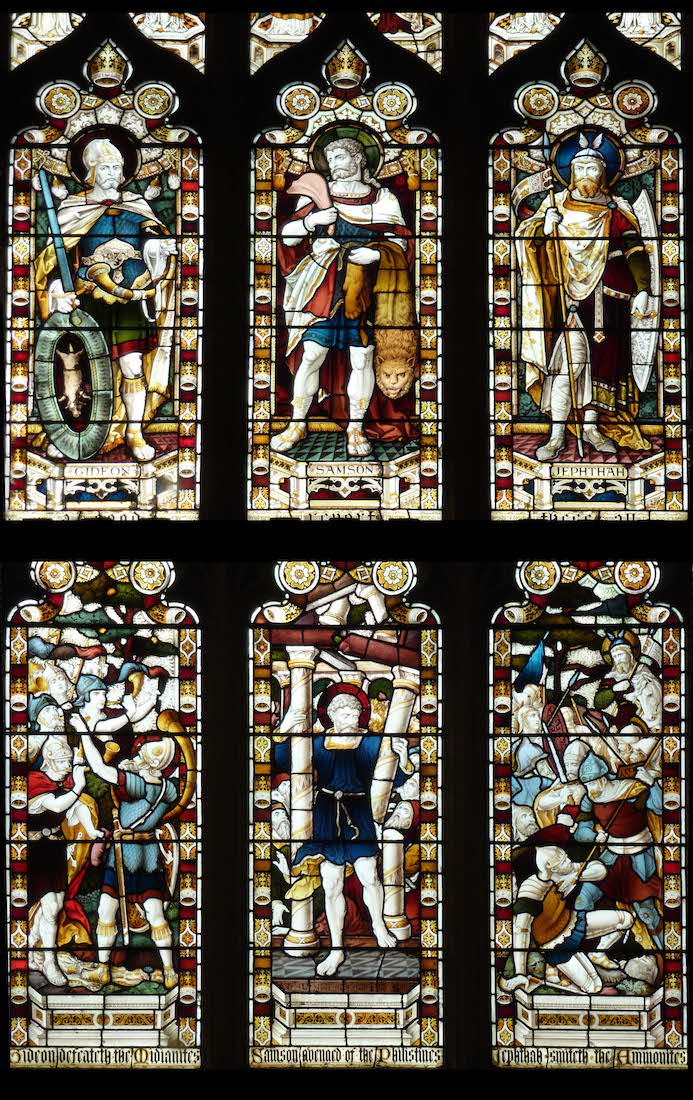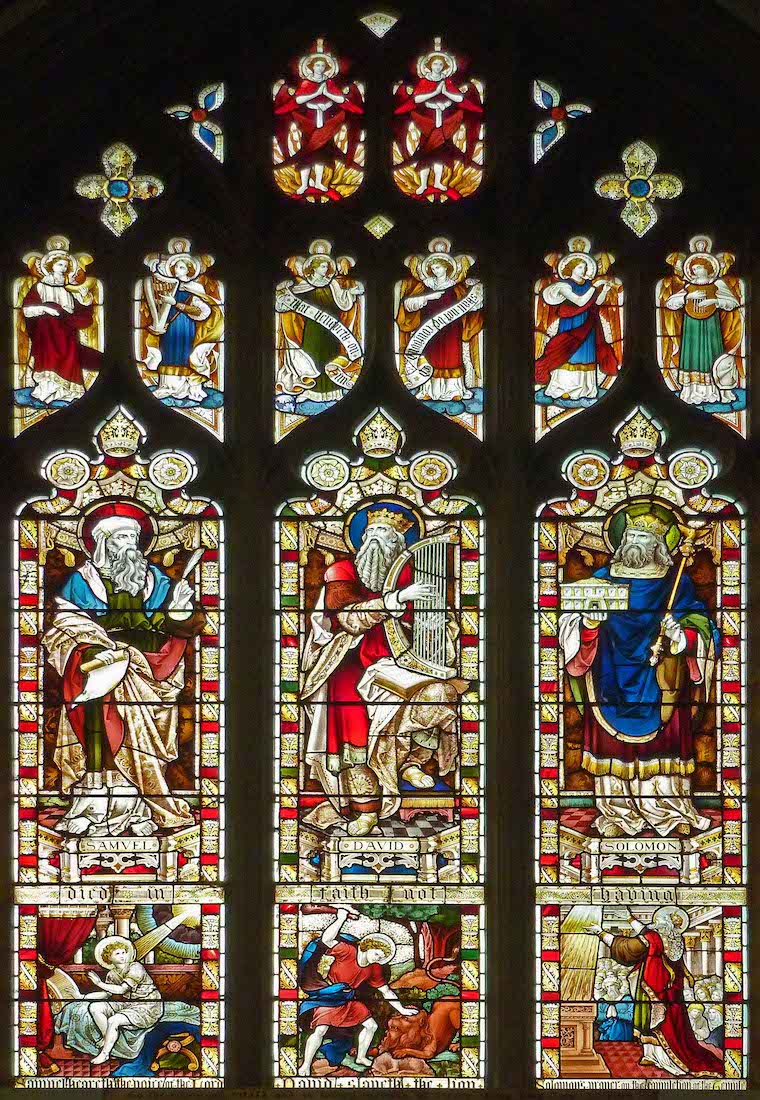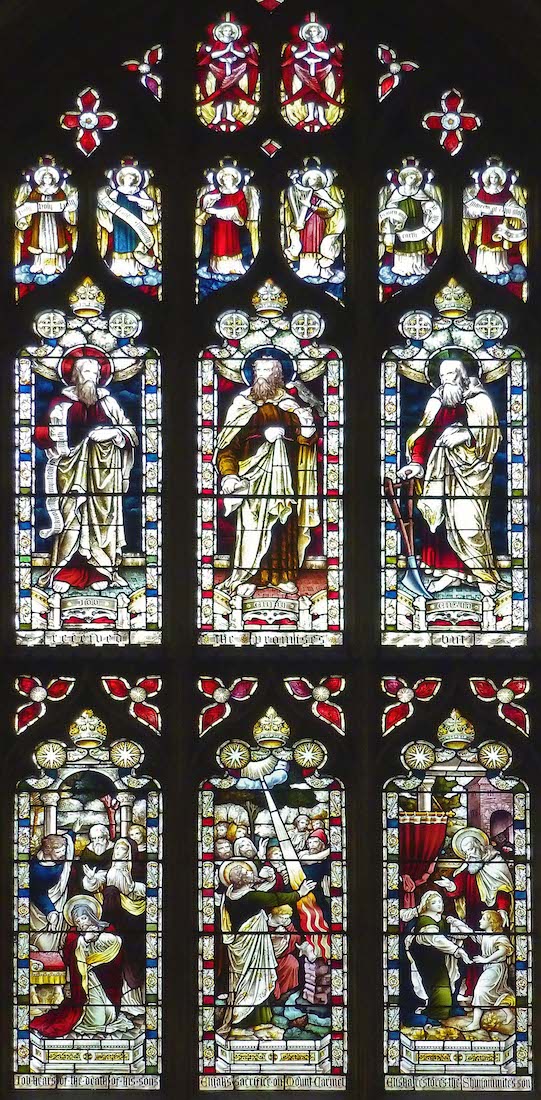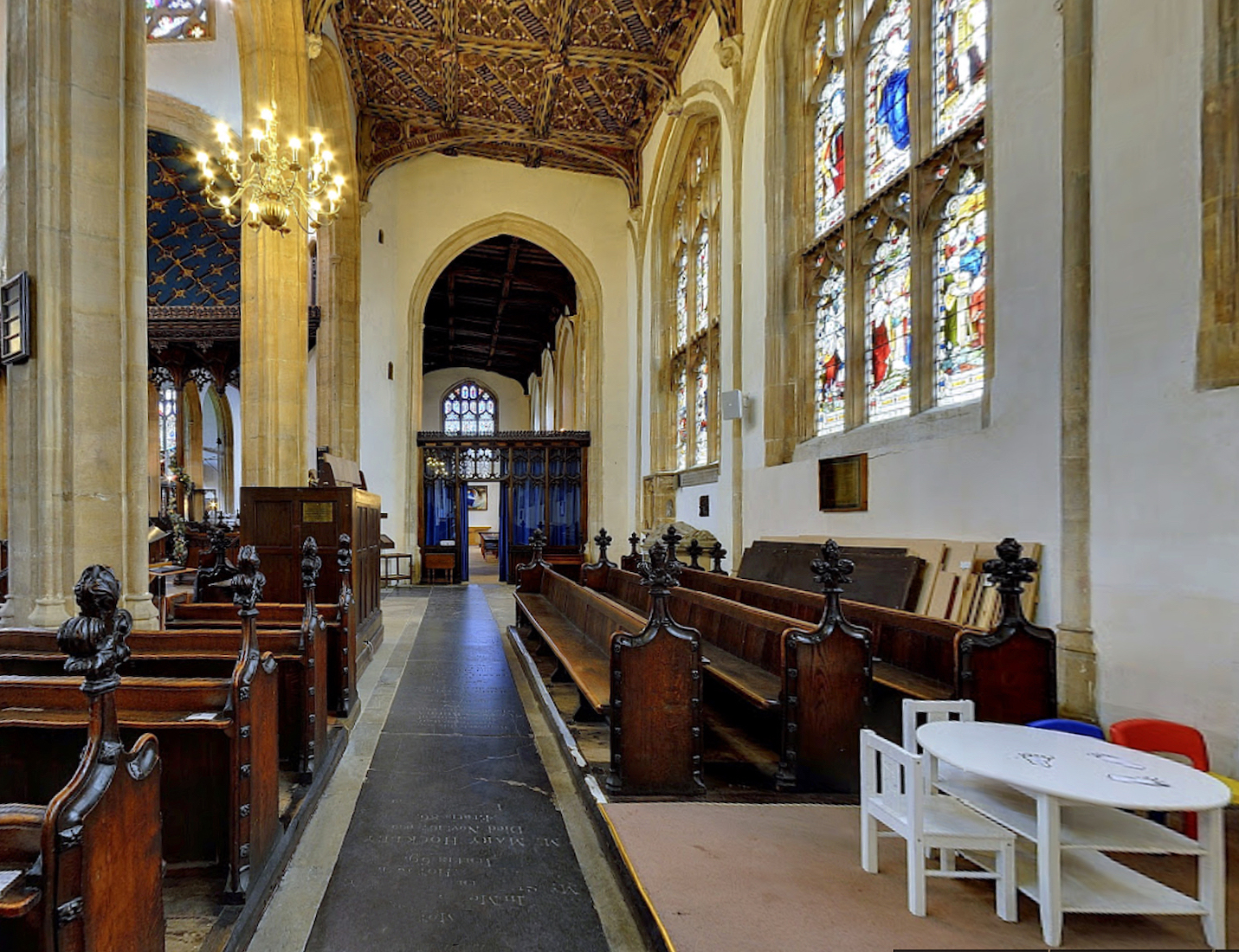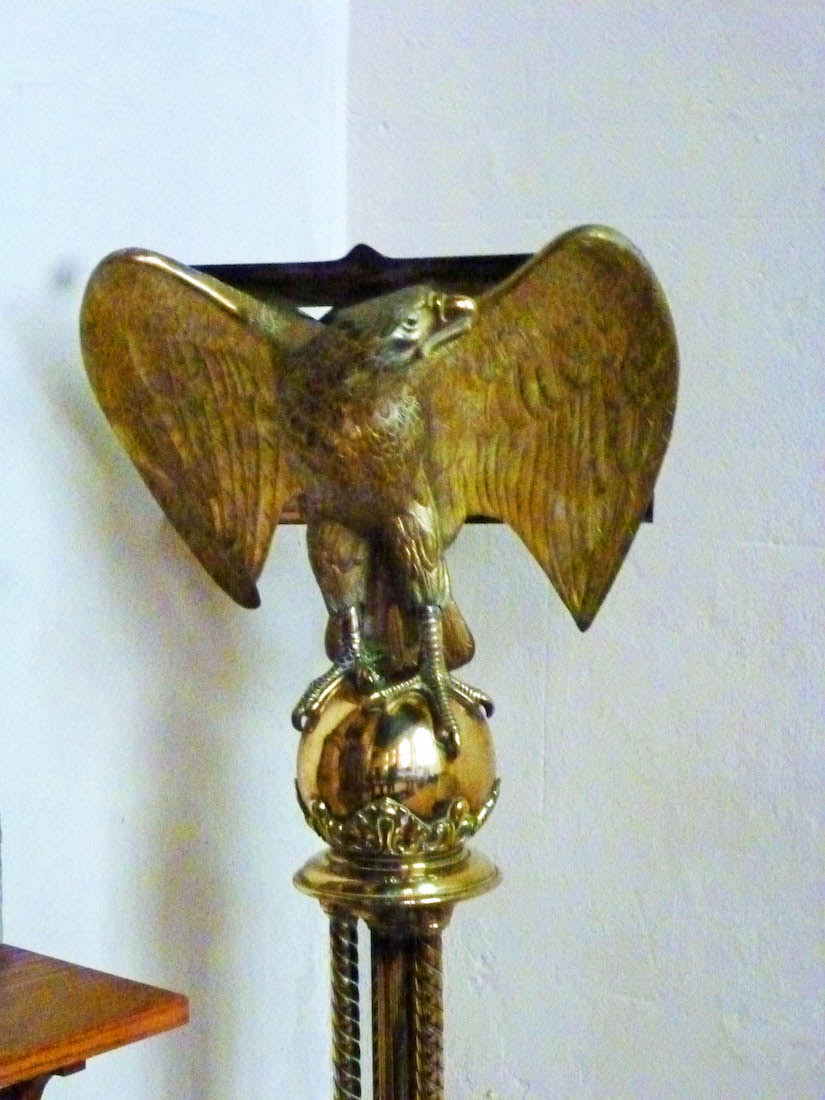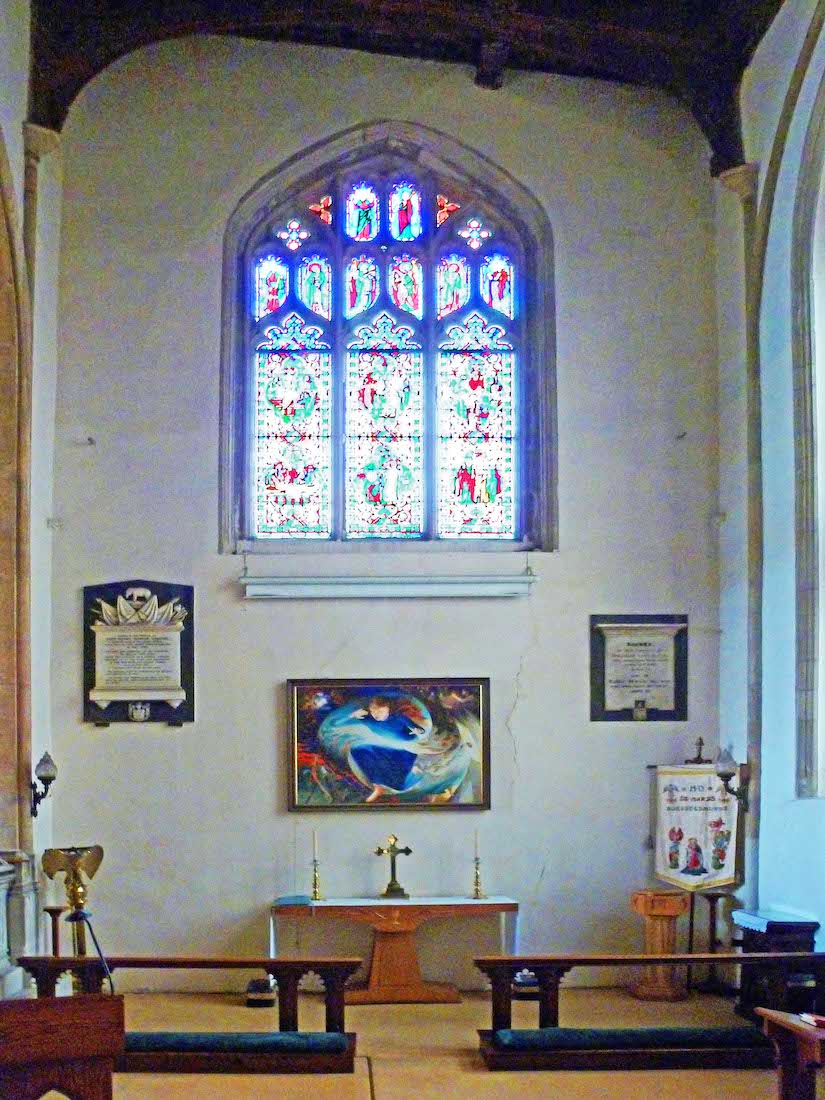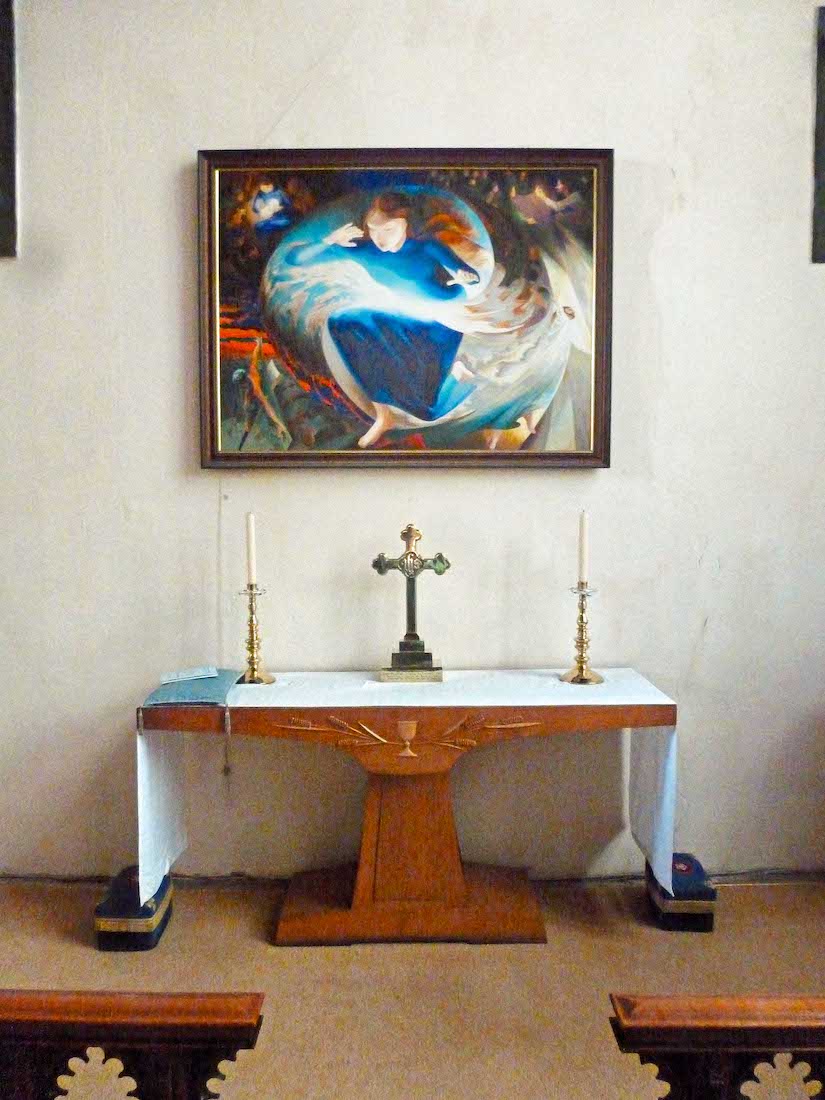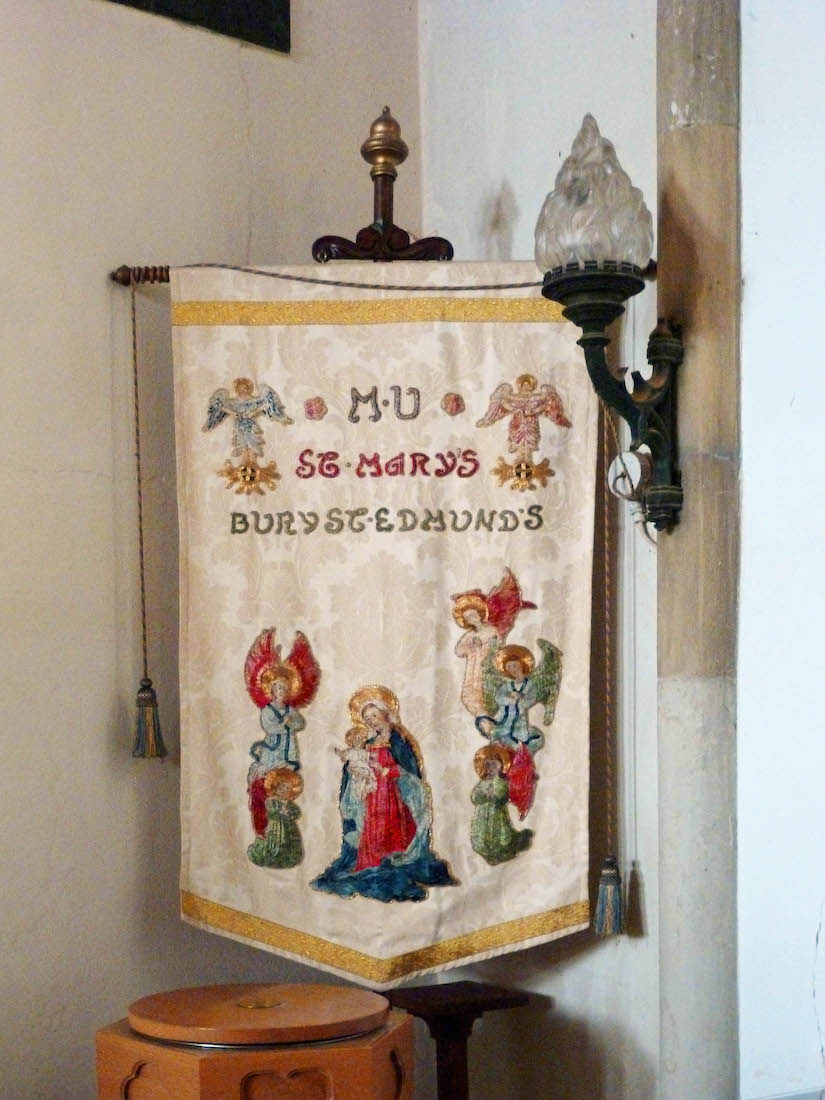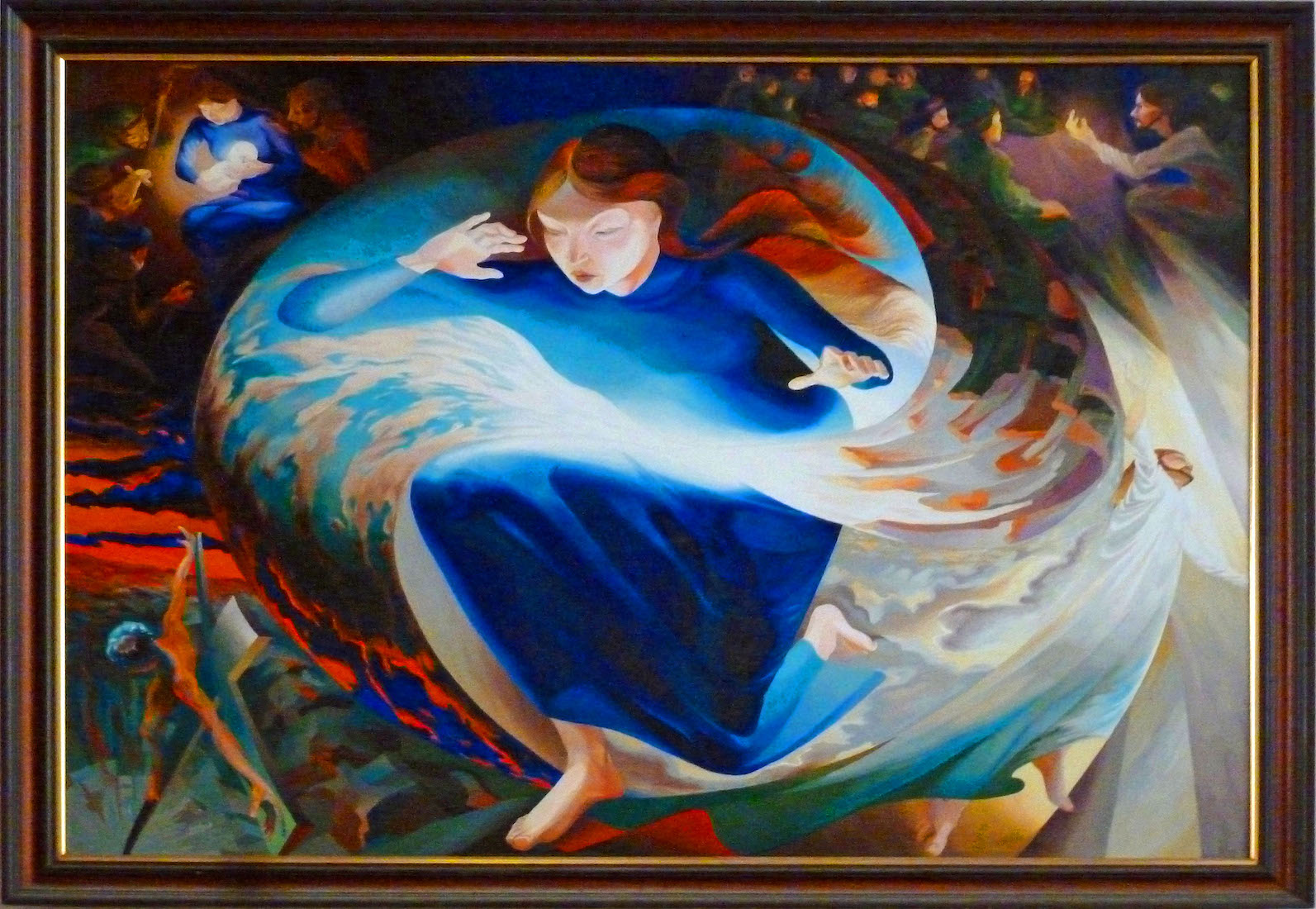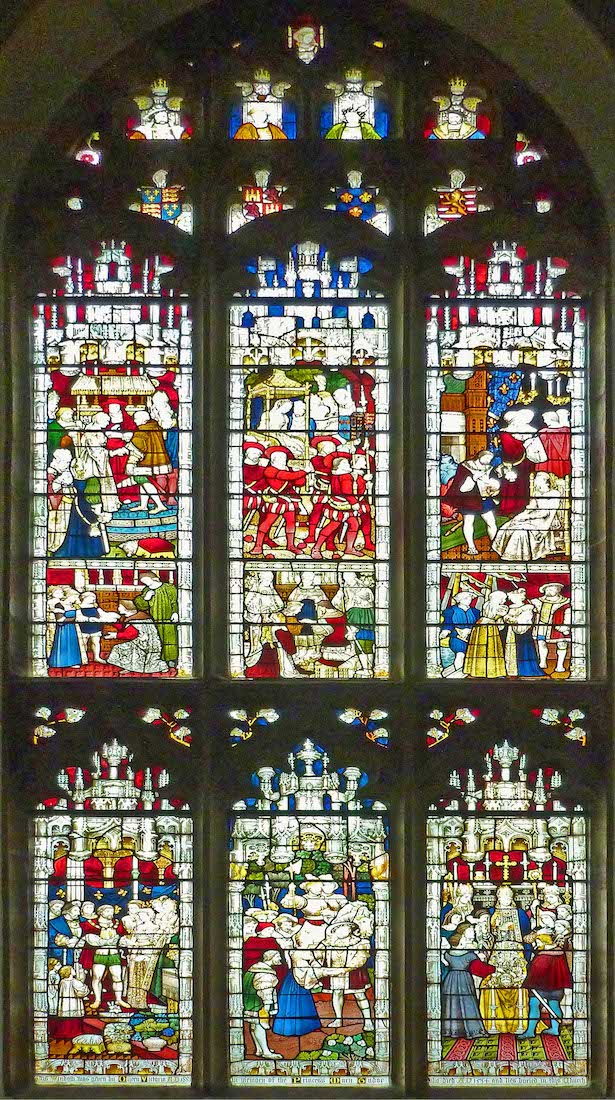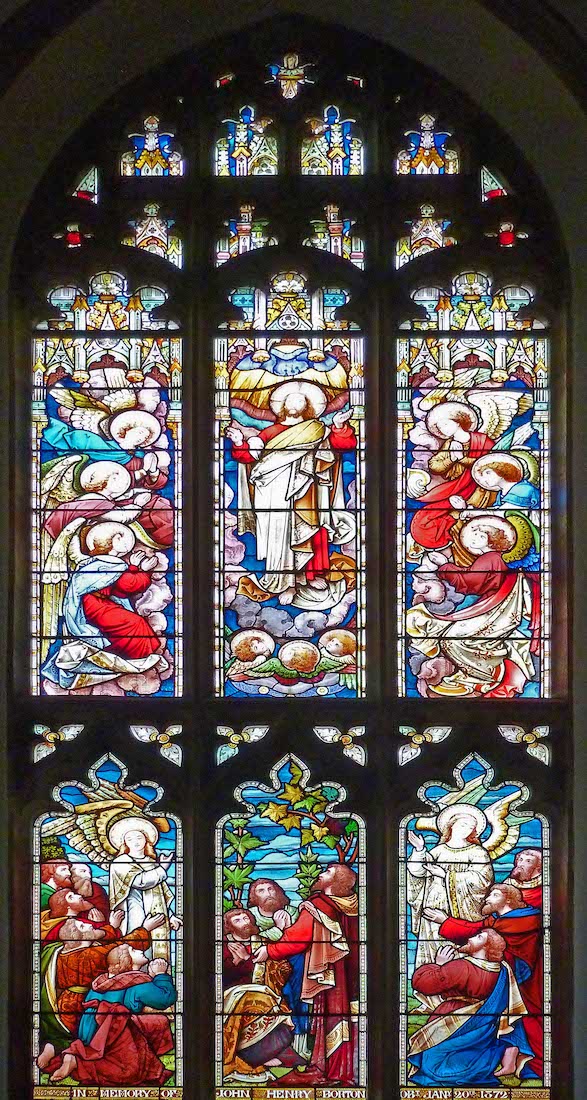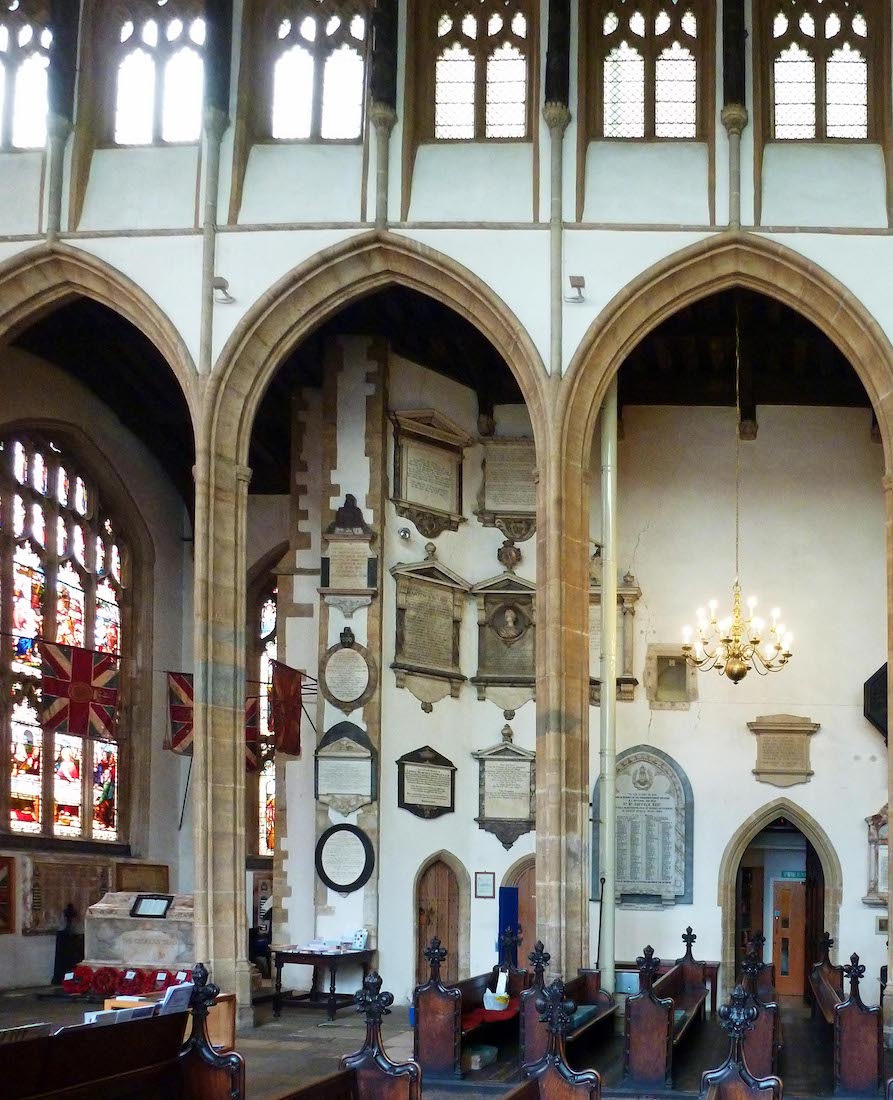
Looking across to the Northwest corner, we see St Wolstan’s Chapel, and the side wall of the tower covered with various tablets and memorial plaques. This photograph is now out of date, as the War Memorial tomb has since been moved to the front of the Church, and this Chapel enclosed with a wooden partition. However, it does show the position of the windows in the Chapel. INDEX
22. NORTHWEST CORNER WINDOWS GA GA
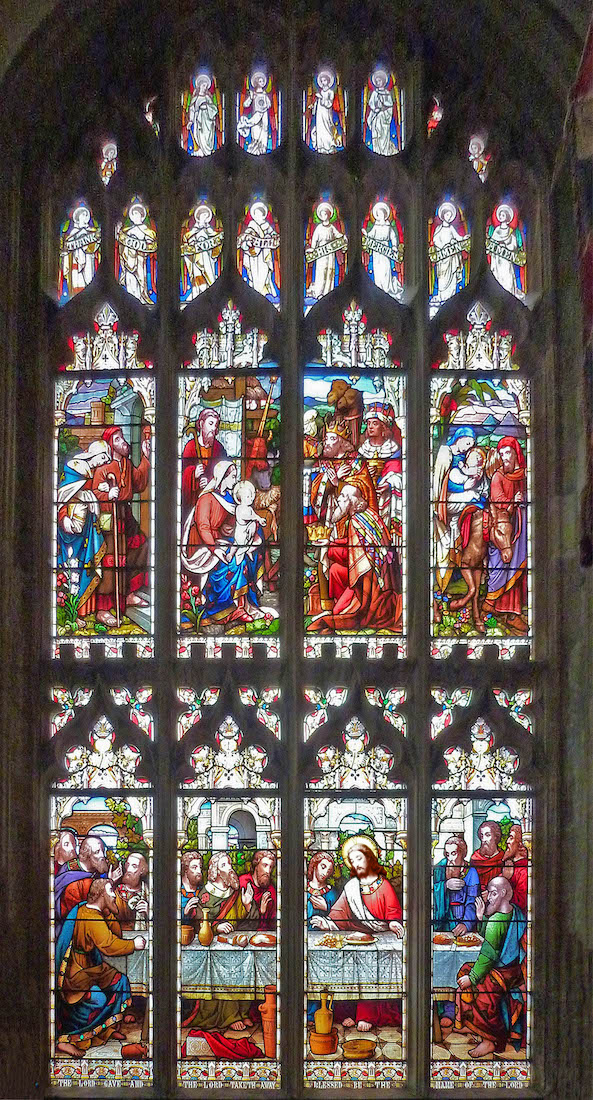
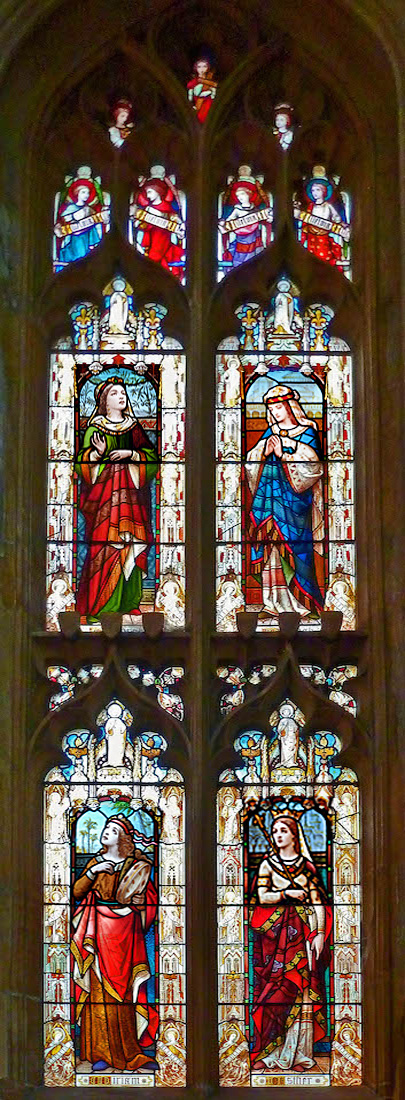
The left (West) window shows across the top: No room at the inn; Epiphany; and the Flight into Egypt. The four panels across the bottom depict the Last Supper. The window is by Ward and Hughes, 1868. • The right (North) window is by Hughes, 1869. It shows four women of the Bible: Hannah(?), Ruth, Miriam and Esther.
23. WALL OF PLAQUES GA
Simon Jenkins says of this scene: ‘the north aisle by the tower has its memorials spectacularly displayed. They climb up the wall to the ceiling, a Valhalla of Bury worthies’.
24. TO NORTH AISLE AMT
We move across to the North aisle to inspect the windows. The first three windows are clear. Remembering that the window above the door (obscured in the photo, but above the blue curtain) also has clear glass, we might expect to see three stained glass windows along this wall.
25. NORTH WINDOWS GA GA GA
From left to right, the windows show: • Some of the shields which were rescued from the old West window. • The Transfiguration window by Ward and Hughes, 1884. Shown across the bottom are St James Major, St Peter and St John. • A window by Clayton and Bell, 1895. The three bottom panels are entitled ‘Mine own familiar friend hath laid great wait for me’; ‘Behold the man’; and ‘Touch me not for I have not yet ascended to my Father.’
26. WAR MEMORIAL CL CL
At the East end of the aisle we come to this large cenotaph with a book of honor which commemorates the dead of the Suffolk Regiment and their relatives. Four mourning angels, two on either of the long sides, represent France, Flanders, Egypt, and Palestine. The memorial was dedicated on 15 March 1920 but was subsequently altered to include World War II. The cenotaph was moved here in 2014 from its previous position in St Wolstan’s Chapel, to bring it close to the Regimental Chapel. Other war memorials line the wall behind.
27. PULPIT GA GA
Near the War Cenotaph stands a classic old pulpit. From here the Gospel is proclaimed Sunday by Sunday.
28. TO SOUTH SIDE CL
We now cross the nave past the lectern to the South side, where an effigy lies in state beneath a beautifully decorated roof. We also notice the console of the Church organ.
29. LECTERN GA AMT
The brass eagle lectern is of standard design with the eagle standing on a globe, and the lectern supported by three lions. The Scripture is read from here each week.
30. JOHN BARET TOMB GA GA
Beyond the lectern, and against the South wall, is the John Baret tomb. John Baret died in 1467. He was a wealthy and well-connected merchant. His cadaver tomb (erected by 1463) and chantry ceiling survive in this Church. The design of John Baret’s tomb is unusual. In most surviving English sculpted cadaver monuments, an image of the deceased in life tops the tomb, and a carving of them as a corpse is placed below, usually within some form of cage structure. John Baret’s memorial inverts this pattern. His sculpted, full-sized cadaver occupies the top of the tomb, while the image of Baret in life is much smaller, carved only in low relief and positioned low down. Similarly, the tomb inscriptions stress Baret’s sinfulness and invite prayer for his soul, but without highlighting his worldly achievements or status. Baret’s tomb thus emphasises death, unworthiness and his status as a sinner.
31. BARET CEILING GA AMT
Baret’s effigy was originally placed here within a chantry chapel, but then the effigy was placed in close to the South wall. The gilded ‘stars’ at each corner within the ceiling have a piece of mirror to reflect the light.
32. SOUTH AISLE WINDOWS AMT GA
This a view of the South aisle, looking towards the baptismal font. There are seven stained glass windows along this aisle, but we have already seen the window closest to the font. Shown at right here is the window above the Baret effigy. It depicts Abel, Enoch and Noah above scenes from their lives.
33. SOUTH WINDOWS GA GA GA
From the left, these windows show: • across the top, Abraham, Sarah and Isaac with life scenes below; • Jacob, Joseph and Moses with life scenes below; • Joshua, Rahab and Deborah with life scenes below. All designed by Heaton Butler and Bayne in 1881.
34. MORE SOUTH WINDOWS GA GA GA
The next three windows show, from left: • Gideon, Samson and Jephtha, with life scenes below; • Samual, David and Solomon with life scenes below; • Job, Elijah and Elisha with life scenes below. All designed by Heaton, Butler and Bayne in 1881.
35. TO THE LADY CHAPEL CL
We return down the South aisle past the organ console to the curtained Lady Chapel. Old memorial slabs line the aisle.
36. LADY CHAPEL GA GA
Although this 1463 chapel is designated the ‘Lady Chapel’, only the painting above the altar points to this. In the left corner is a very interesting old eagle lectern, and an expected Mothers’ Union banner to the right. There is a central altar, and behind, a painting, East window and two memorial tablets.
37. CHAPEL ALTAR AND BANNER GA GA
The wooden altar is simple and attractive with its decoration of chalice and heads of grain. It bears a cross and two candles. At right is the Mothers’ Union banner. Almost every Anglican church and cathedral has one of these, and almost always appearing in the Lady Chapel.
38. CHAPEL PAINTING GA
This colourful painting by John Williams called ‘The Incarnation’ appears above the altar in the Lady Chapel. The painting was given to the Church in 1982 by St Mary’s Children’s Church, to commemorate their 21st anniversary in October of that year. It shows Mary, kneeling at the centre, dazzled by the Light of God at the moment of Incarnation. Surrounding the central figure are scenes from the life of Christ ; Nativity, Teaching, Crucifixion and Resurrection.
39. CHAPEL EAST WINDOW GA
This window is by Alfred Gerente of Paris and dates from 1857. The panels depict the Resurrection, Jesus appearing to his disciples, and the Ascension.
40. CHAPEL SIDE WINDOWS GA GA
There are four windows on the South wall of the Lady Chapel. The first two from the East are shown here. The one at left is a 19th century window by Clayton & Bell and dates from 1881. It was presented by Queen Victoria in memory of Princess Mary Tudor, Queen of France and Duchess of Suffolk. This is the Mary Tudor, sister of Henry VIII, after whom the ship ‘Mary Rose’ was named. The windows tell the story of Mary Tudor’s life. • ‘Ascension Day’ is the second window from the East (shown at right here) and is by Henry Hughes, 1872.



